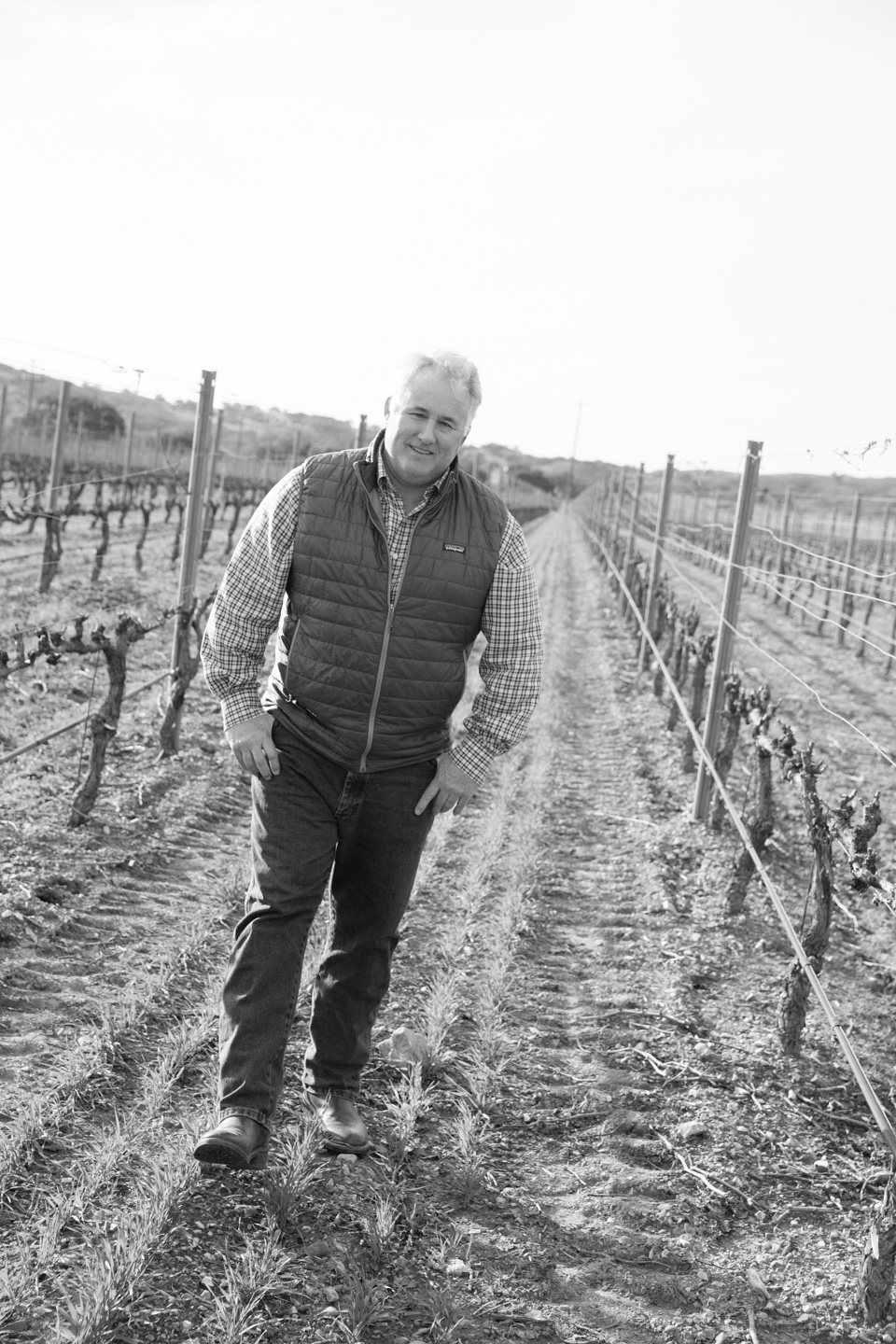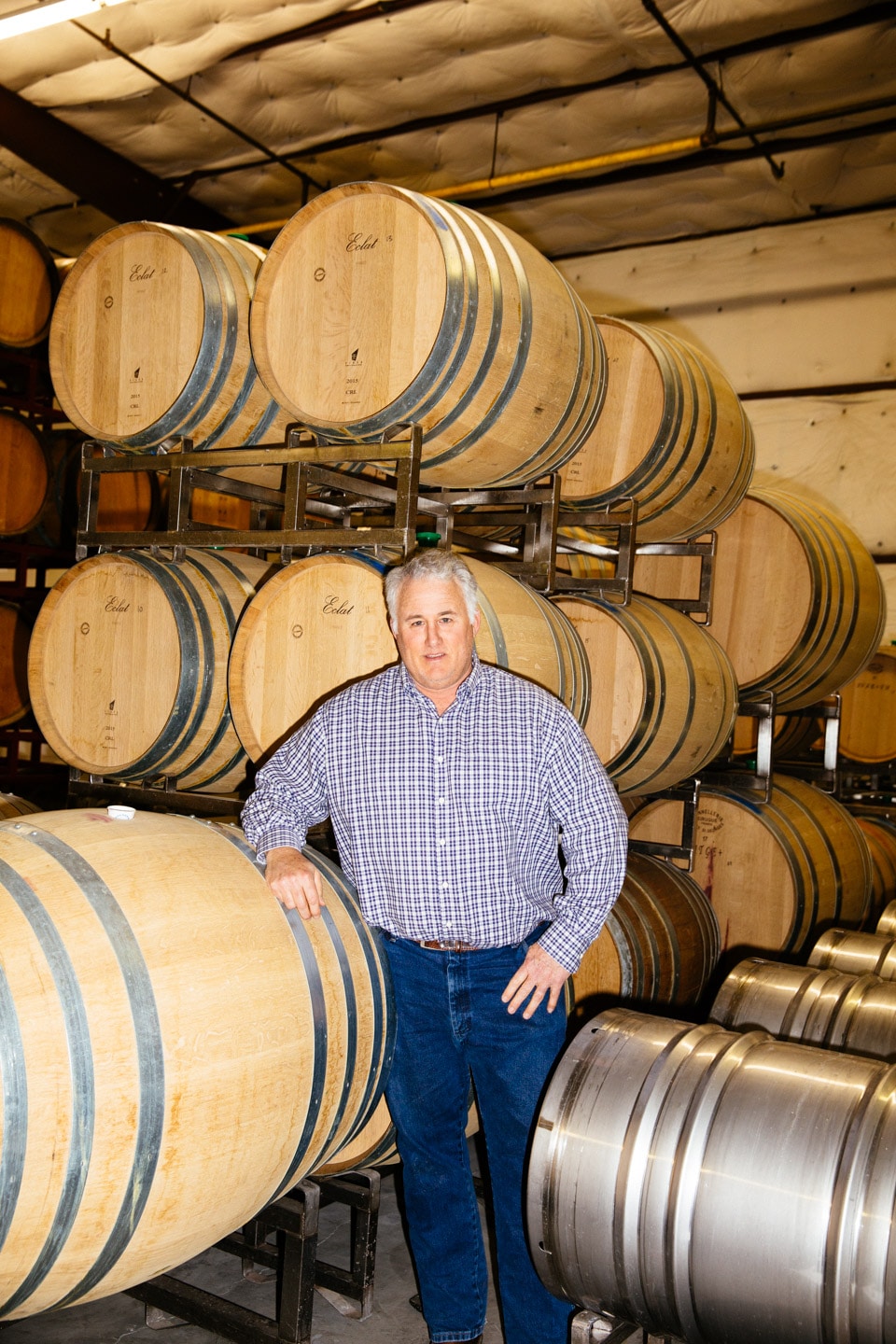Winemaking has its own inherent pace. A process so connected to the land and the fruit it bears, the grape, must follow and respect the cycles of nature — and seasons can’t be rushed. Time itself becomes an important ingredient in a bottle of wine. Not only the natural time in between harvests, but the necessary period of aging inside barrels. The leisurely pace of appreciating a glass of the finished product can, when dialed down, also open up whole worlds of flavors hidden to the hasty drinker.
“Reds take 18 to 24 months in a barrel, and once you bottle it, it still has to sit for at least 6 months. It could be three years from the time you pick your grape to when you get to actually sell the wine,” says Fred Williamson, 57, winemaker and founder of Rivahil Winery in rural Santa Barbara.
The Rhythm of Winemaking
The tempered and cyclic rhythm of winemaking sets the tone for the winemaker’s own life, both at work and away: “With the harvesting, it’s very long hours; one day might be working from 3am to 10pm. But that’s three months out of the year, and after that you get a huge break where you just have to come in and check on things,” explains Williamson. “I get to surf a lot more then, and I get my own hours. I’ll surf all up and down the California coast.”
Personal and Professional Burnout
But Williamson’s life hasn’t always had such a tranquil cadence. Up until 2004, his rhythm had been that of the big city, Los Angeles, and his work beat to the demands of the press at the city’s biggest newspaper, the LA Times.
Williamson worked in marketing and advertisement for the paper for over a decade, being there at a particularly hectic period for the industry as it transitioned from print to digital. Added to the strains of his job, which he was growing tired of, Williamson was also going through a divorce.
“I was at a crossroads. That period made me rethink where I wanted to go with my life,” he says.

Taking a Leap
He took the leap and quit in 2005, after having been relocated to Santa Barbara to work for the paper’s Ventura office a year before. “It was a lot of the same thing: a lot of sales and meetings and being stuck in an office.”
Having decided to stay in the Santa Barbara area, Williamson settled in a small town called Carpinteria and briefly dabbled in commercial real estate. The unfavorable economic climate of the early 2000s however, meant he ended up taking a job at another local newspaper. It was during those years at the Santa Barbara News-Press that Williamson got to know the winemaker Craig Jaffurs.
A Pivotal Encounter
Wine has always been a part of Williamson’s life. He is a knowledgeable drinker who has been collecting as a hobby for many years. Every month he meets up with a group of friends and fellow wine lovers to try out a new bottle over dinner. When Williamson expressed a curiosity towards winemaking over one of these dinners back in 2009, a friend suggested he go meet Craig Jaffurs, who owned a winery near Carpinteria and who often had volunteers helping out with bottling.
“So I went in and offered to help,” says Williamson, laughing as he reminisces about that first encounter. “Craig looked at me, I was in my late 40s, and he probably thought, ‘Why is this old guy coming down and wanting to come work in a winery?’ — because I’m his age, and the people he hires are usually in their 20s.”
Newspaperman to Winemaker
It might have been their shared age bracket or their common love for surfing, but over those weekend hours volunteering at The Jaffurs Winery, the two men struck up a friendship. “I was learning everyday. He was mentoring me. I asked a million questions about the wine, what kind of yeast, and what kind of barrel… I peppered him with a lot of questions,” tells Williamson.
Over the following three years, Williamson nurtured his interest in winemaking, maturing his knowledge and skills at the winery until eventually deciding to have a go at making a batch of it himself. He purchased the grapes with Jaffurs’ help and set up a makeshift winery in his garage.

Early Success
“I was working at the paper in Santa Barbara and helping Craig on the weekends, and doing this as a hobby in my garage. It was trial and error, but the first batches I did turned out fantastic,” he remembers. “All of a sudden I had 8 barrels of wine in my garage, that’s way more than I could drink, and it was turning out so well that I thought maybe this could be a business.”
Beachside Community
It’s now been 7 years that Williamson has been producing wine commercially. He moved his barrels from his garage to Buellton, where he set up Rivahil Winery. The winery is a 45-minute drive from where Williamson lives, and although he doesn’t need to go there every day, he will usually rent a place nearby during the busy harvest months. For the rest of the time, he will work from his home office in Carpinteria.
The picturesque town is nestled between the Pacific Ocean and the Santa Ynez Mountains and famed for its agricultural produce: its widespread cultivation of avocados has made it the home of a yearly Avocado Festival since 1987, and a past of Dutch settlers means that the area also boasts a healthy flower production. Its beaches lure in bathers and surfers alike, due to both the sandy stretches and good swell, and in winter they are the resting spot of seals and sea lions. Carpinteria is the perfect example of a surviving Californian beachside community — tranquil on the one hand but still vibrant enough in its local traditions and ways.
Wine-Tasting Room
Another 40-minute drive up north is the charming western-style town of Los Olivos, where Williamson has set up a tasting room. “It’s a little shop front with some restaurants and other tasting rooms nearby. We have a sandwich board on the sidewalk that attracts passersby — mainly people on vacation. We also do a wine club that people can join and we’ll do dinners and tastings,” says Williamson.
Locally Minded
The aesthetics and values of Rivahil Wines are in perfect harmony with its surroundings, starting with its labels which feature a drawing of a yucca, a plant indigenous to the region. It’s only right that an area so famed for its agricultural produce will give great importance to provenance, with many restaurants in the Santa Ynez Valley only serving fresh and seasonal food.
“There is a big farm-to-table movement here, and that’s kind of in the area we want to be. It’s all about local, naturally made wines — we try to use a minimal amount of sulphur, and the grapes come from organic vineyards,” says Williamson.
Community Driven
Drawing on local strengths has also meant that Williamson’s family has been an important part of the winery’s story, and on Rivahil’s homepage you are greeted by a picture of Williamson, his three children and his wife and her two children. “It’s been a very family-oriented business; we have stomped grapes and done bottling together,” he says.
Friends have also been key to the business: “We sometimes do bottling in the weekends and friends come to help out. We bring out a nice lunch and we try to make it fun. A lot of people are curious about it, and some friends love it and want to come back again and again.”
Lifestyle Refresh
Rivahil Winery wasn’t only a career change for Williamson, it was an entire lifestyle change. Being able to draw pleasure from the job is an integral part of that lifestyle, and Williamson wants that to be extended to everyone involved, be it family, friends, employees, or consumers. Sales, for instance, which was a strictly-business matter in the media industry, at Rihavil became a personal and pleasant endeavour: “We pour in different events. I have a friend with a band and we sponsor his concerts and get our name in the building. That’s the fun part, doing events. It’s sort of sales but people are having a good time, enjoying the wine. The best part is sharing it with people.”
The winery has also given Williamson a wonderful sense of community that big corporations and cities can often lack. He has close relationships with the people he works with, often including employees, consultants or even an artist which might be helping out on the label’s design.
Quality at a Reasonable Price
“Life’s short, keep good vibes and make it fun,” he says, smiling. Williamson is aware that it is the business’ size, still fairly small, that makes it intimate, and he would rather curb his ambitions by focusing on quality rather than quantity, to keep things that way.
His production focuses on southern Rhône varietals, and although these are boutique wines by definition, prices remain reasonable: “I’d like it to be a profitable business but I’m not expecting to make loads of money. I’m not building a multi-millionaire brand — it’s about the lifestyle,” he says.
The Art of Winemaking
Williamson has just finished bottling his rosé wines, made from grapes which were picked five months ago and whose seeds were planted years before. When working with a product for which time itself is such an important ingredient, hindsight, the evaluation of time gone by, also becomes relevant.
As Williamson explains, small changes throughout the process that might have gone by unnoticed at the time of occurrence can have a huge effect on the flavor of the wine years down the line. The variables are infinite, from uncontrollable elements such as the weather to the type of wood the barrels are made of, amount of yeast added and a million things in between. Mapping these alterations becomes a cross between a memory exercise and a guessing game.
“It’s artistic. All the nuances you are pulling in, and you are creating something. And whatever you create, it continues to evolve and change in the bottle — you are working on this living thing,” says Williamson.
Evolving with Time
Williamson also applies hindsight to his own path: given how long it takes to make a bottle of wine, there are advantages to starting earlier in the game. “I wished I had looked into winemaking before. It seemed like something too hard to do, but after having looked into it, I realized it’s not that hard. I wish I started 20 years ago,” he says.
Having started his journey with winemaking in his late 40s might mean that Williamson has fewer vintages under his belt, but perhaps, just like a good bottle of wine, some ideas just need time to mature and flourish.
The ideas expressed here are solely the opinions of the author and are not researched or verified by AGEIST LLC, or anyone associated with AGEIST LLC. This material should not be construed as medical advice or recommendation, it is for informational use only. We encourage all readers to discuss with your qualified practitioners the relevance of the application of any of these ideas to your life. The recommendations contained herein are not intended to diagnose, treat, cure or prevent any disease. You should always consult your physician or other qualified health provider before starting any new treatment or stopping any treatment that has been prescribed for you by your physician or other qualified health provider. Please call your doctor or 911 immediately if you think you may have a medical or psychiatric emergency.
AUTHOR

We will never sell or give your email to others. Get special info on Diet, Exercise, Sleep and Longevity.
